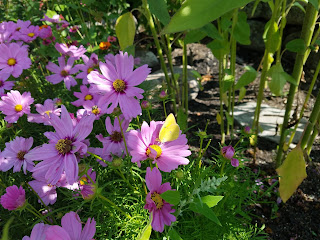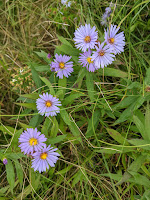Native Cultivars: Our New Silent Spring
 Several years ago I bought a "native" coneflower at the farmers market. It was double flowered, looked really great in the pots, the same species name as the native coneflower and it said 'native' right on the label. I knew that coneflowers (echinacea) were great for bumblebees, moths and butterflies and this one looked really special. I planted it right next to a few more traditional looking coneflowers.
Several years ago I bought a "native" coneflower at the farmers market. It was double flowered, looked really great in the pots, the same species name as the native coneflower and it said 'native' right on the label. I knew that coneflowers (echinacea) were great for bumblebees, moths and butterflies and this one looked really special. I planted it right next to a few more traditional looking coneflowers.What I saw during the year was that there was never a single bee, moth or butterfly on the "native" cultivar but the traditional coneflowers had many. As it turns out, the marketing of 'nativars' or cultivars of native species as actual native plants at markets and even well respected nurseries is becoming a real problem. Giant factory scale greenhouses replacing the use of native species in our landscaping with sterile varieties. Unfortunately, as my experience showed, these cultivars have been selected for ornamental traits and often do not perform the same (or any) ecologically beneficial role. As they become more prevalent, habitat for species is lost.
Check out this article discussing how and why bees and other pollinators, and their larval forms, cannot use many of these fancy plants we see at farmers markets and nurseries. In some cases, it might even be better to plant non-natives, such as these cosmos below, than to plant these factory raised plants sold as natives that local insects may never use. Of course, the best approach is to look for seed or plant suppliers like Prairie Moon Nursery that provide open pollinated varieties that also provide food for larval stages, in addition to being something nice to look at on a summer day.



Comments
Post a Comment